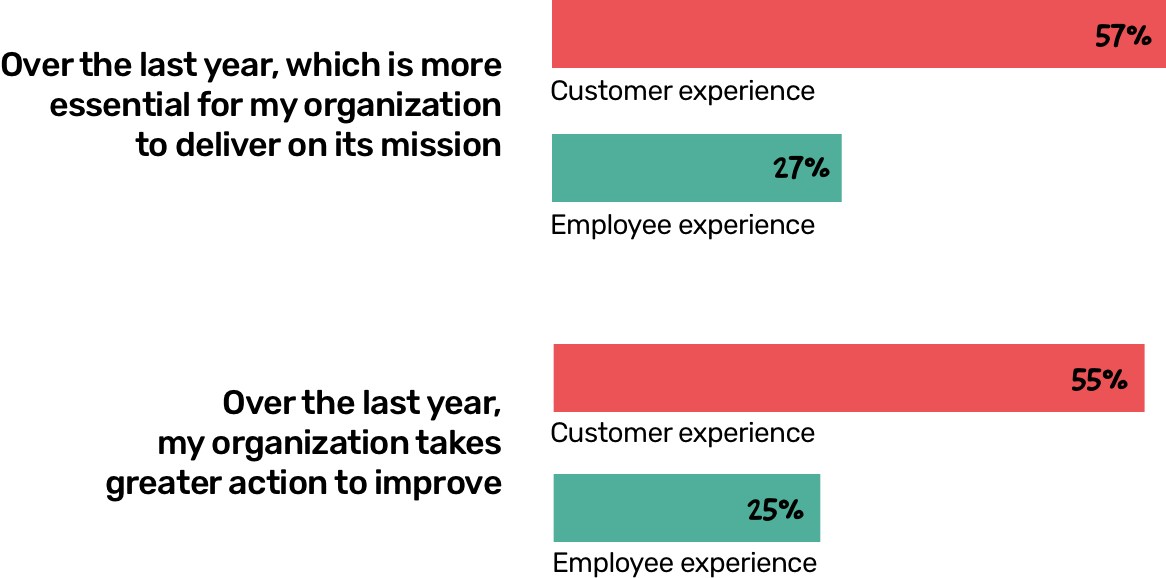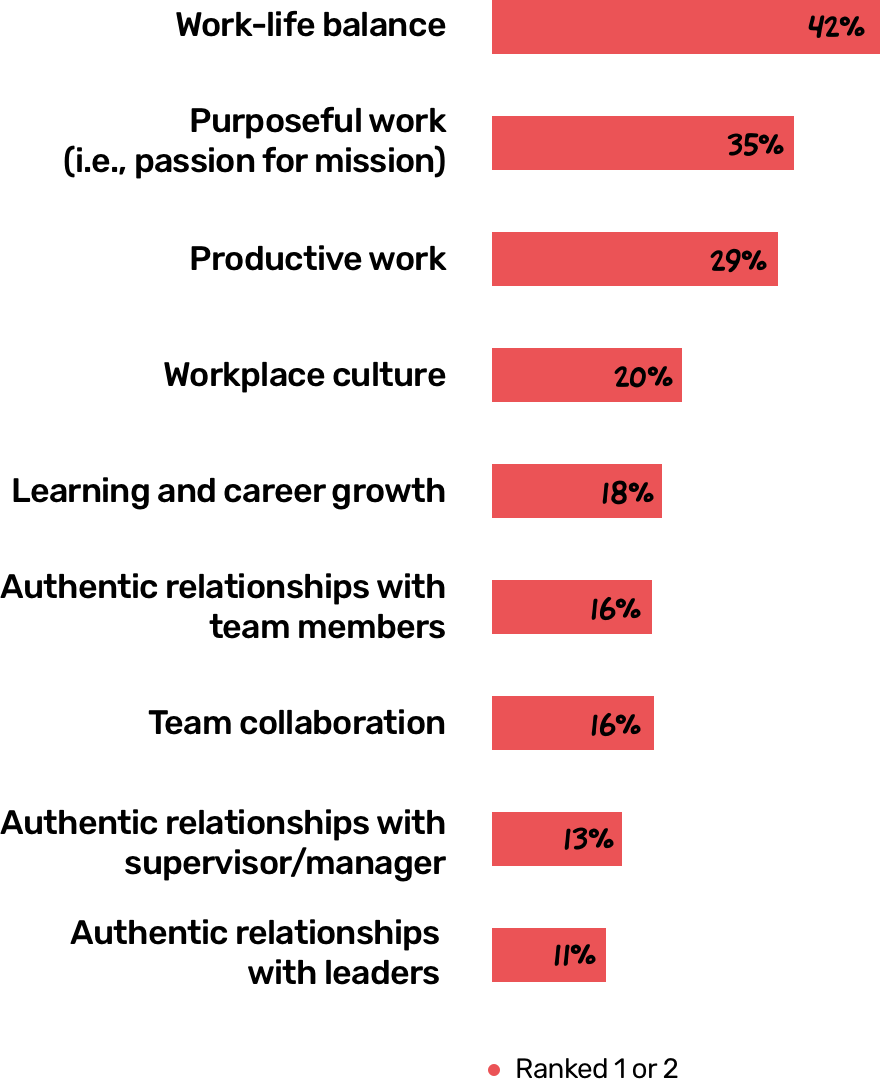Report
Are customer experience problems coming in through the employee entrance?

Related services and insights
Employee experienceUncovering ROI: The hidden link between technology change and employee experience
Excellent customer experiences start with strong employee experiences.
Customer experience challenges begin much further upstream than organizations realize. Eagle Hill’s survey of more than 1,000 U.S. employees across industries finds that the relationship between the employee experience and customer service may be the most important, yet overlooked, piece in the customer experience puzzle. Sixty-four percent of US workers say that the employee experience impacts their ability to serve customers. Yet, less than half (38%) say that their organization places a great deal of importance on employee experience / satisfaction, according to research by Eagle Hill Consulting.
The relationship between the employee experience and customer service may be the most important, yet overlooked, piece in the customer experience puzzle.
With the American Customer Satisfaction Index now at its lowest point since 2005, and citizen satisfaction with federal government services at its lowest point since 2015, Eagle Hill’s survey of more than 1,000 U.S. employees across industries finds that the relationship between the employee experience and customer service may be the most important, yet overlooked, piece in the customer experience puzzle.
A customer service focus alone won’t move the customer experience needle very far
Organizations certainly are paying attention to customer experience—and their employees have noticed. Respondents in our survey say nearly 60% of employees feel their organization places a great deal of importance on customer experience/service, yet less than 40% feel their organization places a great deal of importance on employee experience/satisfaction.
As shown in Figure 1, by a margin of nearly two to one, national survey respondents say their organizations both weighted customer experience as more important to delivering the organizational mission (57%) and took greater action to improve customer experience (55%) than say their organization considered employee experience more important (27%) and took greater action to improve it (25%).
Figure 1: Employees see vast disparity in how organizations prioritize customer experience and employee experience

Source: Eagle Hill Consulting Employee Experience Survey 2021
Certainly, organizational investments in customer experience make business sense. For example, research from Zendesk found that 75% of customers are willing to spend more to buy from companies that give them a good customer experience and that 80% will move business to a competitor if they have more than one bad experience.
However, the employee experience also has considerable ripple effects for the customer experience. The big investments organizations have made for years to improve the customer end of the customer experience—enhancing self-service options, enriching websites, and offering greater channel flexibility, for example—do not touch the human relationships that lie at the real heart of the customer experience. And more than ever they crave a level of interest and care for their problems that can only come from invested and engaged employees.
The relative neglect of employee experience plays out as employee frustration in multiple areas, with potential customer experience implications
A majority of national respondents agree that their feelings about their day-to-day work experience—negative or positive—impact their productivity (70% impacted) and their ability to do meaningful work (69%).
When employees feel dissatisfied about their experience at work, however, the negative impact becomes profound. In our survey, dissatisfied employees are much more likely than satisfied ones to say their feelings about their day-to-day work experience negatively impact their productivity and their ability to serve customers. Moreover, unsatisfied employees are more likely to say they do not provide excellent customer service and to say they do not deliver quality outcomes (Figure 2).
Figure 2: Negative feelings about the employee experience negatively impact the customer experience
Being productive
My feelings about my day-to-day work experience negatively impact my productivity.

Serving customers
My feelings about my day-to-day work experience negatively impact my ability to serve customers.

Providing excellent customer service
I provide excellent customer service.

Delivering quality outcomes
I deliver quality outcomes.

Source: Eagle Hill Consulting Employee Experience Survey 2021
Interestingly, more survey respondents said their day-to-day experiences positively impacted their ability to help others (63%).
The takeaway for organizations is that the relative lack of emphasis on the employee experience leads to downstream effects on the customer. Moreover, some of the customer experience ramifications of negative employee experience will be much harder to root out and solve than others. For example, our survey found that employees who say they are dissatisfied with their overall experience at work are much more likely (22% versus 6%) to say that that their feelings about their day-to-day work experience negatively impacts their willingness to help others.
Issues of productivity and performance manifest in metrics. The thorny problems of employee attitude and motivation are difficult to root out and solve.
Issues of productivity and performance manifest in metrics, and organizations can lean on employees to improve in those specific areas. The bigger question is, how do organizations deal with the thorny root problems of employee attitude and motivation? By developing cultures that support the employee experience, equipping them to do their jobs with confidence, supporting their career progression, and demonstrating their overall physical and emotional well-being matters to management.
Weakened team dynamics and remote work affect the ability to jointly serve customers
After a year of solitary working, it’s not very surprising that employees feel better about their individual contributions than they do about their team dynamics. Introspection, self-reliance, and perhaps some surprise in how much they could accomplish outside of the traditional office setting has employees feeling good about themselves. In fact, our survey found that 95% of national respondents agree that they deliver quality outcomes and 94% agree they provide excellent customer service and are productive at work.
While employees feel good about themselves as individual performers, however, they feel far less confident in their teammates’ abilities and performance. For example, in our survey, 19% of respondents cite having to do the work of underperforming colleagues as their top source of frustration at work.
When asked to reflect on the factors they valued most at work, respondents in our survey were much more likely to rank individualistic factors in the top two than they were to rank factors related to teamwork. For example, 41% rated work-life balance as a top-two factor, followed by purposeful work (32%) and productive work (30%). In contrast, only 12% of respondents ranked authentic relationships with team members and team collaboration among their top two most valued factors at work (Figure 3).
Figure 3: Employees appear to value individualistic factors more than team-based ones at work
Which factors do you value the most in your day-to-day work experience?

Respondents ranked the factors from 1 to 9 with 1 being the most valuable.
Source: Eagle Hill Consulting Employee Experience Survey 2021
The weakened team dynamics glimpsed through these findings hint at a much larger issue: that excellent customer experiences depend on strong and cohesive teams that trust each other. As the Wharton Business School article by David De Cremer, What COVID-19 Teaches Us About the Importance of Trust at Work notes, “Trust is important to the functioning of organizations because of its indirect effects. That is, when trust is in place people will act in certain ways and it is those behaviors that will eventually lead to outcomes that drive performance.”
Excellent customer experiences depend on strong cohesive teams.
The increased complexity in enabling collaboration over the past year has made it more difficult for employees to innovate and to work together in teams to solve customer problems. A full quarter of respondents (25%) in our survey disagree that they feel connected to their colleagues. As post-COVID working models expand to include more in-person team opportunities, it is time for managers to take a strong hand in strengthening team connections. Right now, less than half of national respondents (41%) in our survey say their manager/supervisor demonstrates care/concern about their interactions and relationships with team members. Employees already feel good about their work contributions; it is up to management now to pull all the individual islands of excellence back together.
Technology is a key to better customer experiences, but organizations need to unjam the lock
Employee attitudes on technology are decidedly mixed. While 67% say technology improves their ability to serve customers, 22% say technology actually makes it harder for them to do their work. Overall, more than one third of respondents in our survey (35%) say technology frustrates them.
While it’s not clear the specific technologies that employees feel help or hinder them, the message about needing more support to use technology to perform better, certainly is. Nearly one out of three of our national survey respondents (31%) say they do not get the technology training they need to succeed. We see this finding as an opportunity. Employees have shown they want to do an excellent job; they need their organizations to provide the right support to succeed.
Previous Eagle Hill research found that 36% of employees say the nature of their work has changed amid COVID-19. During the pandemic, employees have felt pulled into work they typically wouldn’t do. They have been introduced to a slew of new processes, ways of work, customer interactions—and technologies. All of these changing factors underscore the seriousness of properly preparing and supporting employees to maintain excellent customer experiences. We see this finding as an opportunity. Employees have shown they want to do an excellent job; they need their organizations to provide the right support to succeed.
Nearly one out of three respondents say they do not get the technology training they need to succeed.
Given the importance of the employee experience to the customer experience, Eagle Hill recommends these steps organizations can take to improve both.

Influence customers’ experience by designing around employees’ experience. Probing how employees think and feel about all interactions with the business and externally with customers will illuminate challenges, motivations, and opportunities to improve the employee experience. That, in turn, will have positive ripple effects for the customer experience. Think through all touchpoints across the employee experience with a customer focus and explore whether these touchpoints cause employee distress or call for greater support based on their impact. For example, do employees need their roles more clearly defined; do they have the right technology and training to serve customers; are they surrounded by high-functioning teams? The answers to these questions should guide future investments.
A diverse cross-section of employees can illuminate unseen gaps in the customer experience and potential remedies, based on their first-hand experience.

Involve employees in designing your customer experience strategy. Enlist the input of employees from across the business when shaping your customer experience strategy. Beyond the data or hypothetical maps you may have developed, a diverse cross-section of employees can illuminate unseen gaps in the customer experience and potential remedies, based on their first-hand experience.

Emphasize group cohesion. How employees support one another in the workplace, both in their day-to-day work and in other aspects of their lives, contributes to an environment where employees feel comfortable bringing their whole selves to work and engaging with their peers. Previous research from Eagle Hill found that team leads/manager (46%) and teammates (25%) are most influential in driving change. Inspire these groups to create a culture that supports and respects the individual. Build social belonging through affinity groups, offsites, and team outings (virtual or in-person) and communicate frequently about team expectations and changes. Then, give employees control over how teams operate.

Show all employees that what they do has a meaningful impact on customer outcomes. Employees want to feel that how they spend their time at work creates value for the business. In fact, our survey found that 32% of employees ranked purposeful work among the top-two factors impacting their day-to-day experience (second only to work-life balance). Link all employee roles not just to business impact but also to customer impact. For example, an employee responsible for HR programs supports employee growth and motivation, which ultimately affects their ability to serve customers better. An employee in IT creates and implements technologies that make a difference in how effective their colleagues can be in serving end customers.

Establish what a “customer-centric mindset” looks like in action. Without organizational guidance, few employees will make the explicit connection between vision statements and the tactical actions and behaviors they can take to improve customer experience. Break down the vision statement into the specific values all employees should hold to create an exceptional customer experience and corresponding actions and sample behaviors. Getting all employees on the same page about what the customer vision looks like in practice is the starting point of individual and team accountability.
Without organizational guidance, few employees will make the explicit connection between vision statements and the tactical actions and behaviors they can take to improve customer experience.

Tie employee metrics to customer metrics. In our survey, 26% of respondents say their organization does not measure employee engagement and satisfaction. If your organization is among this number, start now by listening to your employees and collecting data on the voice of the employee. Pulse surveys, biannual surveys, and regular feedback sessions with employees can all help organizations better understand and empathize with the employee viewpoint. As you review this data, zoom into the resources, tools, processes, and culture that help employees create positive value for the customer. And don’t just stop there. Analyze key customer experience and employee experience performance indicators side-by-side in a joint dashboard. Shifts on the employee experience side (such as employee satisfaction and turnover) could be leading indicators for performance on the customer experience side (such as customer satisfaction).
Methodology
The Eagle Hill Consulting Employee Experience Survey 2021 was conducted online by Ipsos in January 2021. The survey included 1,003 respondents from a random sample of employees across the United States. The survey polled respondents on employee experience aspects, including technology, diversity, employee engagement, and customer service.

